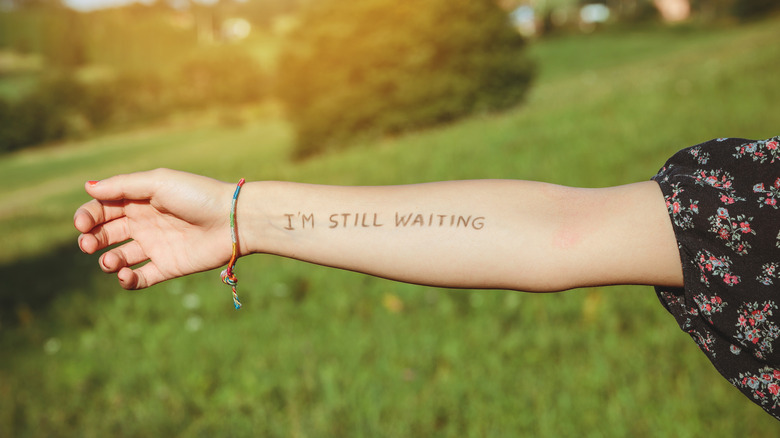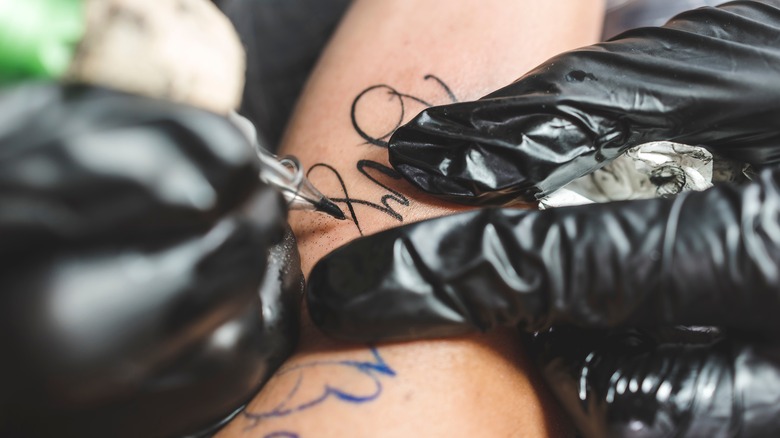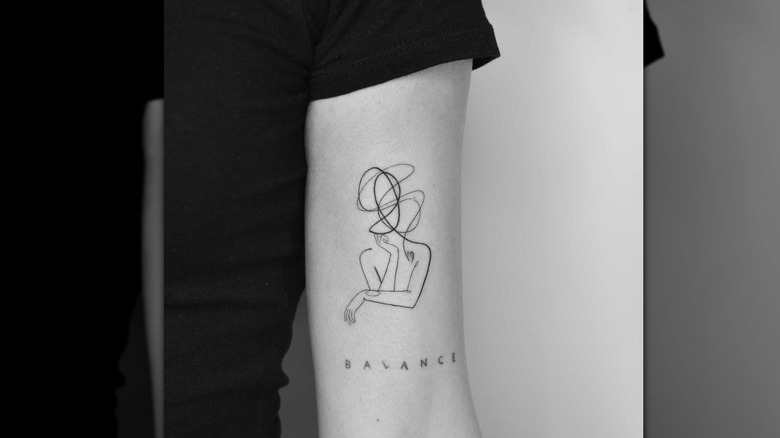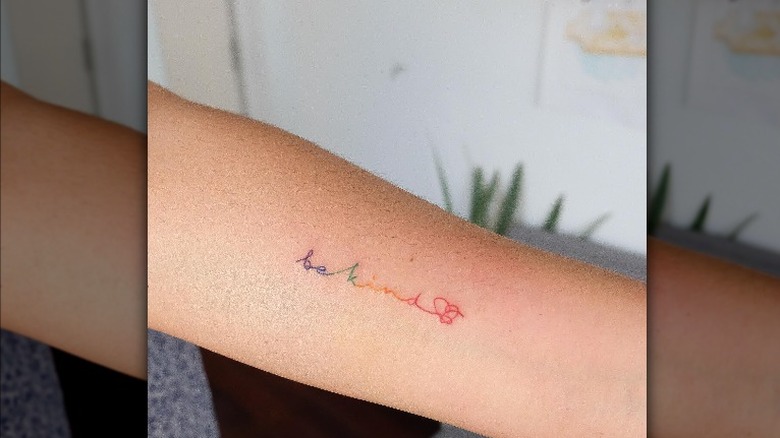Your Guide To A Timeless Tattoo Font
Tattoo trends come and go, but the ink on your skin is forever. If you've already committed to the idea of getting a word or phrase tattooed on you, your next step is the delightfully fun hurdle of selecting the perfect font for your new ink. Perhaps you already have one in mind. Maybe it's the feminine Ballast font, which you've undoubtedly seen while scrolling fine-line tattoos on Instagram, or a classic Typewriter look. Or maybe you prefer a big and bold Olde English. Whatever your style preference, there are some basic fundamentals of script and typographic tattoos that you'd do well to remember.
Ahead, we've rounded up guidance on what to consider when looking for a timeless tattoo font — because no matter where you are in your tattoo planning journey, it never hurts to research all of your options before taking the permanent plunge. Save the pain for the ink session itself!
Size matters
Your tattoo artist will definitely tell you this, but the size of the font is crucial when it comes to lettering. If you opt for a tiny cursive script with minimal spacing between letters, the tattoo will become blurry over time. This is because the ink lives in the dermal layer of the skin; as you age, your skin loses collagen and becomes less elastic causing the ink to spread slightly. Of course, a little bit of ink migration is inevitable no matter what type of tattoo you get, but this can lead to illegibility when it comes to small lettering that is bunched up or close together.
"Your lettering will likely double in thickness over time," advises Jordan Le Fae, a popular TikToker and tattoo artist in a video. "So the bigger you make your lettering, the more legible it will be in the long run." Certain areas of the body are more prone to fading over time; too. These include the palms of your hands and fingers, feet, underarms, and under the breast depending on chest size.
Not all needles are created equal
Tattoos are an art, and there are many different specialties. Find an artist who specializes in the type of tattoo you want, especially if you're going for the small script, fine-line lettering scrawl, like the "Ballast" font or a similar delicate look. There are often different needle types for micro tattoos, so it's important to find an artist who not only has the skill but also the equipment!
"Many people assume that all artists can do fine-line work, but finding someone who specializes in micro tattoos is very important," advises tattoo artist Alissa Jung to Insider. "Not every artist has experience using single needles or small-needle groupings, which can lead to poor line work or blowouts." A blowout, in tattoo terms, occurs when an artist accidentally injects the ink too deeply into the skin and hits the fat below; the end result looks as if you spilled water on an ink drawing.
Think about placement
When opting for a timeless tattoo font, it's important to consider what ink you might want to add to your body in the future. Celebrities like Miley Cyrus have added small, fine-line tattoos over the course of several years, and if you're considering growing a similar collection, you might want to consider how the tattoo font will look in juxtaposition with your future ink aspirations. Large, cursive script tattoos on the forearm, for example, might not jibe well with a fine line tattoo on the wrist! Your body is a canvas — but it's also limited real estate.
"I'd think about where you want to put it first, and how you're thinking you want it to look on your body," Gabby Pignanelli, a tattoo artist at Inked NY in New York City, tells Allure. There are places online where you can create temporary tattoos; if you know you'll want more in the future, you can make a low-commitment investment and try out imitations of what you want before you actually take the plunge.
Browse around and have fun with it
If you have the phrase or word selected but are totally open to different font styles, there are seemingly endless options to choose from. When perusing, it can help to have a little bit of typography 101 on deck. The common categories include: Serif fonts, which have tails or stems, like Times New Roman; Sans Serif, which have no feet or tails, like Arial; script fonts, like cursive lettering; or decorative fonts, including custom designs created by your artist—or even your own handwriting or the handwriting of a loved one.
There are plenty of online resources that can help you play around without making any actual commitment. You can even try using an online tattoo font generator, which gives you an approximation of what the tattoo will look like on different skin tones. If you are truly open, you can also ask your artist for a recommendation, as they will have their go-to sites and favorite font families. "My personal favorites are handwritten for a natural look or calligraphy for a cleaner look," says tattoo artist and TikToker Oskana Weber, who uses Dafont to research different styles. "Take the time to choose the best font option for you," she says.
Take it from the experts, and happy inking!
Colors fade faster
A timeless tattoo is one that is more resistant to fading. If you're averse to the idea of going in for touch ups, opting for vibrant or rainbow colors for your script tattoo might not be ideal—though they sure do look lovely! "Tighter, more detailed work tends to work better in black and gray," acclaimed tattoo artist Nick the Tailor tells Byrdie. "With black and gray, the most important consideration is value. Light versus dark tones. This lends itself to readability, even on a small scale." There are also some colors you should try to avoid. Even fair skin is naturally darker than yellow or white ink in most cases, tattoo artist Gianna Caranfa warns to Insider. "Since tattoos are in the second layer of skin, the first few days of a tattoo in this pigment will look bright and visible; however, once the first layer grows back over, it will be hidden by your skin tone," she says.
There are ways to incorporate color into your tattoo without having it be the script itself. Watercolor's soft, textured look adds a splash of color to black ink and can nicely complement a delicate line tattoo. Of course, you can also commit to having touch ups, which leaves your color options much more open.




